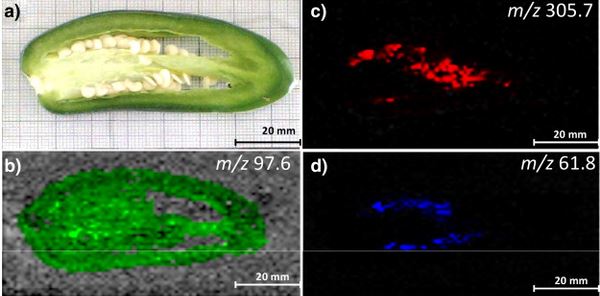 Mauricio Maldonado-Torres, José Fabricio López-Hernández, Pedro Jiménez-Sandoval and Robert Winkler
Mauricio Maldonado-Torres, José Fabricio López-Hernández, Pedro Jiménez-Sandoval and Robert Winkler
J Proteomics. 2014 May 6; 102:60-5. Epub 2014 Mar 15.
Mass spectrometry imaging (MSI) is of high and growing interest in life science research, but the investment for necessary equipment is often prohibitive for small research groups.
Therefore, we developed a basic MSI system from low cost ‘Plug and Play’ components, which are connected to the Universal Serial Bus (USB) of a standard computer. Our open source software OpenMZxy (http://www.bioprocess.org/openmzxy) enables automatic and manual sampling, as well as the recording of position data.
For ionization we used a low-temperature plasma probe (LTP), coupled to a quadrupole mass analyzer. The current set-up has a practical resolution of 1 mm, and a sampling area of 100 × 100 mm, resulting in up to 10,000 sampling points. Our prototype is easy and economical to adopt for different types of mass analyzers.
We prove the usability of the LTP-MSI system for macroscopic samples by imaging the distribution of metabolites in the longitudinal cross-cut of a chili (Capsicum annuum, ‘Jalapeño pepper’) fruit. The localization of capsaicin in the placenta could be confirmed. But additionally, yet unknown low molecular weight compounds were detected in defined areas, which underline the potential of LTP-MSI for the imaging of volatile and semi-volatile metabolites and for the discovery of new natural products.
Biological significance
Knowledge about the spatial distribution of metabolites, proteins, or lipids in a given tissue often leads to novel findings in medicine and biology. Therefore, mass spectrometry based imaging (MSI) is becoming increasingly popular in life science research. However, the investment for necessary equipment is often prohibitive for small research groups. We built a prototype with an ambient ionization source, which is easy and economical to adopt for different types of mass analyzers. Therefore, we hope that our system contributes to a broader use of mass spectrometry imaging for answering biological questions.


No responses yet